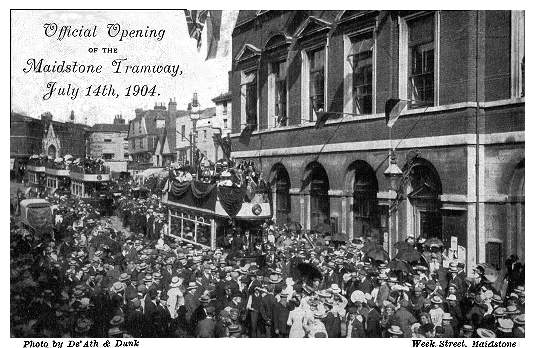

Maidstone, the county town of Kent situated on the River Medway about 9 miles south of Chatham, had plans for a (horse) tramway as early as 1880, but they were not pursued until more serious proposals were put forward in 1900 for an electric tramway. These resulted in the construction of a small 3ft 6in gauge system, that opened a hundred years ago on 14th July 1904 with a route from the High Street to the "Fountain Inn" at Barming, two miles west of the town centre.
Our centenary postcard shows four of the original six trams in the High Street outside the town hall during the opening ceremony. The local firm of De'Ath & Dunk published the card and this particular example was posted from Maidstone to Windsor exactly one month later, on 14th August 1904.
This tramway, like many other small systems at the time, was built under the parliamentary authority of a Light Railway Order, hence the title. This used the less demanding requirements of the Light Railways Act of 1896, rather than those of the very restrictive Tramways Act of 1870.
Tramway construction, including the later extensions to Tovil and Loose, was carried out by Dick, Kerr & Co. Ltd. of Preston who also provided the first seven tramcars (car no.7 was delivered in 1905). The cars were built by the Electric Railway & Tramway Carriage Works Ltd., also of Preston, and were mounted on Brill 21E trucks of 6ft wheelbase. They were fitted with two Dick Kerr 25B motors of 25 h.p. each and operated by Dick Kerr DB1 Form C controllers. Each open-top car had seating for 48 (22 inside and 26 outside).
In 1907, ten additional cars were delivered for the new routes. They were 3ft shorter than the earlier cars with seating for only 40 but were otherwise mechanically similar. None of the seventeen double-deck cars were ever fitted with top covers. In 1909, a single-deck 'Demi-car' was purchased for the lightly trafficked Tovil route and, remarkably, this car has survived but is awaiting full restoration at Dover Transport Museum.
The route length was only a little over five miles but there were plans to connect with the Chatham system to the north, which never materialised.
Parts of the system were taken over by trolleybuses in 1928 then most of the rest followed after the last tram ran on 11th February 1930. In turn, diesel buses replaced the trolleybus network in 1967.
The livery of the trams was a golden ochre (that sometimes weathered to a greenish yellow) and off-white although some coloured picture postcards of the time show a variety of fanciful but erroneous liveries. The ochre was retained for the later trolleybuses and buses until a light blue and cream was chosen after the trolleybuses were abandoned.
![]() Go to Postcard Of The Month Index
Go to Postcard Of The Month Index